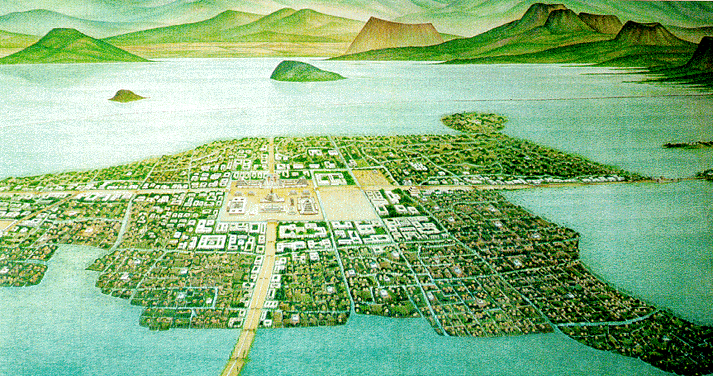Just before famed Spanish conquistador Hernán Cortés pillaged the Aztec capital city Tenochtitlan in 1521, toppling one empire to make room for another, he was astounded by the immense size of its buildings and the wealth of its rulers. The city, he recalled in a letter to Holy Roman Emperor Charles V, was just as large as his home town of Seville. Like any modern city, Tenochtitlan was not without its boulevards, thriving marketplaces for trade, lavish courthouses, temples, and an intricate network of canals. Clearly, the Aztecs had no European cities to model their capital off of, in the way Washington, D.C. was modeled after Paris, but something about it struck a chord as familiar – to Cortes’ own experience home in the Old World.
All cities have their own personality – landmarks and dialects that stand out as well as food staples, but now some anthropologists believe that there is something that transcends cultural barriers – universal laws that gradually find their way into the structure of all urban regions – mathematical rules that may be found in ancient cities as well.
To accomplish their study, the team of researchers analyzed archaeological data from excavations at Tenochtitlan and a number of other sites around it throughout Mexico, finding predictable ways in which all the buildings were put together.
“We build cities in ways that create what I like to call social reactors,” said complex systems researcher Luis Bettencourt, of the Santa Fe Institute in New Mexico.
Bettencourt and his collaborators in Santa Fe have long been working on a theoretical system for understanding where modern cities come from – how they originate and how they gradually expand. The primary reason for urban development is the increased opportunity for people to interact, networking with other people. Due to these increasing relationships among groups, the cities increase in their efficiency. It is actually due to an influx of people that there is a positive correlation with the respective city’s economy. When a city’s population doubles, Bettencourt’s team noticed that very often there’s an estimated 15 percent increase in the city’s overall productivity — a 15 percent jump in wages, in GDP, and also in patents. However, the increase is also associated with about the same increase in violent crime, thus not all increases in population are good.
Bettencourt’s work is challenging the common perception of a city as a pile of brick and steel buildings, and instead beginning to see them as specific constructs to maintain day to day social interactions. To be specific, it is a means of pooling together people of different skill to solve problems that no single individual can solve on their own. It was this realization that caused the team to suspect that this pattern might be observed in ancient cities as well.
“What I realized was that none of the parameters they were discussing in these models had anything to do with modern capitalism, democracy or industrialization,” said Scott Ortman, an anthropologist at the University of Colorado, Boulder, of Bettencourt’s work. “Their parameters are basic properties of human social networks on the ground. And so I thought, ‘Well, gosh, if that’s true, then these models should apply very broadly.”
To conduct their analysis, the team analyzed over 2,000 years of history in Mexico City, from its very beginnings around 500 B.C., right into the colonial period which began in the 16th century. They looked at over 1,550 square miles of land, which contained thousands of settlements throughout its history, starting as little towns containing only a few hundred people, which then burgeoned into immense cities like Teotihuacan and Tenochtitlan, which exceeded 200,000 people.
They published a study in PLOS ONE last year that showed a pattern of population growth similar to cities of today. As they grew larger, populations doubled. Then, when the populations increased, development of the living area slowed by about 83 percent. Their conclusions, Bettencourt said, showed the relationship between social networks and living quarters – in which the former maintains priority over the latter. If cities doubled each time populations increased, cost of living would be too high to maintain.
To compare modern urban economics with these cities, the researchers compared them with the construction of public monuments and temples, with much of these projects being commissioned after the city populations increased. They even noticed a distribution of income similar to today – with wealthier citizens buying larger houses.
“What’s interesting is that this expresses exactly the same as GDP,” Bettencourt said.
The study was published today in the journal Science Advances. Although their research is limited to ancient Mexico, Ortman is intrigued by the possibility that studies of ancient cities throughout the rest of the world might yield similar results – each being the product of ages of social interaction.
“It implies that some of the most robust patterns in modern urban systems derive from processes that have been part of human societies all along,” said Ortman. “I just think that’s an amazing concept.”
|
James Sullivan
James Sullivan is the assistant editor of Brain World Magazine and a contributor to Truth Is Cool and OMNI Reboot. He can usually be found on TVTropes or RationalWiki when not exploiting life and science stories for another blog article. |

